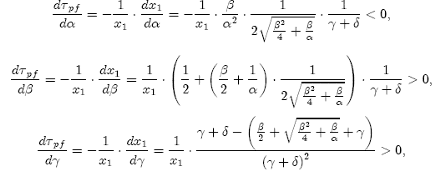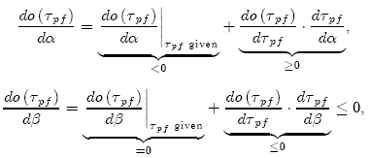It is important that market expectations about future exchange rate movements are not arbitrary, and, given the model, do not involve (persistent) prediction errors. This is to say that the market should have perfect foresight, which means that the first equation in (45) can be ruled out since it implies that the market does not expect that the exchange rate will adjust to longrun equilibrium, even if the exchange rate will do that.
Thus, since the second equation in (45) is the same as (27), (27) is both the stability condition for the model as well as the condition for exchange rate overshooting. In order to characterize the perfect foresight adjustment path to longrun equilibrium, start with de…ning the change of the exchange rate as
 (52)
(52)
Then, (48) evaluated one time period ahead is
 (53)
(53)
which, together with (48), is substituted into the de…nition in (52):
 (54)
(54)
Finally, using (48) in (54) gives the di¤erence equation
 (55)
(55)
which, of course, is similar to the di¤erence equation in (46). Clearly, for the market to have perfect foresight, it must be true that
 (56)
(56)
or, according to (36) and (55),
 (57)
(57)
where the lefthand side of (57) is the expected adjustment speed of the exchange rate and the righthand side of (57) is the actual adjustment speed of the exchange rate. Moreover, τpf is the perfect foresight planning horizon. The general solution of (57) is
 (58)
(58)
Thus, the perfect foresight planning horizon is a function of the structural parameters in the model, and, therefore, endogenously determined within the model. In order to derive how the perfect foresight planning horizon is a¤ected by changes in the structural parameters α, β, γ and δ, define
 (59)
(59)
where the weight function in (5) is utilized in the second step, which means that (57) can be written as
 (60)
(60)
which has the solution
 (61)
(61)
Since (27) implies that x0 < 0, we must have that
 (62)
(62)
Then, the perfect foresight planning horizon can be solved for by combining (59) and (62):
 (63)
(63)
where 0 < x1 · 1 since τpf¸ 0, i.e.,
 (64)
which is soon utilized. Consequently,
(64)
which is soon utilized. Consequently,

(65) (66) (67)
where (64) is utilized in the last step, and
 (68)
(68)
The interpretation of (65)( 68) is that the perfect foresight planning horizon is longer, the less sensitive real money demand is to changes in the nominal interest rate (α), the more flexible goods prices (β) are, the faster the expected adjustment speed of the exchange rate according to technical analysis (γ) is, and the slower the expected adjustment speed of the exchange rate according to fundamental analysis (δ) is. Finally, the e¤ect on the magnitude of exchange rate overshooting of a change in the structural parameters, given perfect foresight, can be derived:
 (69) (70)
(69) (70)
 (71)
(71)
and
 (72)
(72)
where (29), (31) (34) and (65) (68) are utilized[12] in the derivations. Thus, the extent of exchange rate overshooting, given perfect foresight, is smaller the more flexible goods prices (β) are. Concerning changes in the other structural parameters in the model, the effects on the magnitude of exchange rate overshooting are ambiguous. It is important to distinguish between (31) (34) and (69) (72). The former set of equations, i.e., (31)( 34), describes the direct effect on exchange rate overshooting of a change in the structural parameters, while the latter set of equations, i.e., (69) (72), describes the total effect on exchange rate overshooting of a change in the structural parameters.
For example, the direct e¤ect of an increase in the nominal interest rate response of real money demand (α) is to decrease the magnitude of exchange rate overshooting (see the …rst term on the righthand side of (69)). However, the indirect effect of an increase in this semielasticity is to increase the extent of exchange rate overshooting (see the second term on the righthand side of (69)), and this is because a shorter perfect foresight planning horizon (see (65)) increases the magnitude of exchange rate overshooting (see (29)). Consequently, the total effect of an increase in this semielasticity is ambiguous (see (69)).
12 Of course, (29) and (31)( 34) also hold for the perfect foresight planning horizon.
By Mikael Bask and Carina Selander
Next: Simulations of the model
Summary: Index